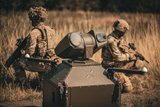BACN demonstrated during US Army NIE
Northrop Grumman has announced that the Battlefield Airborne Communications Node (BACN) has been demonstrated during the US Army's Network Integration Evaluation (NIE) 12.1 at White Sands Missile Range, N.M., and Fort Bliss, Texas. During the exercise the BACN displayed its tactical airborne networking potential to fill certain communications capability gaps.
Northrop Grumman developed and delivered a ground communications gateway capability for evaluation at NIE 12.1, a step toward deploying the BACN gateway on an Army airborne platform. BACN now flies aboard a number of US Air Force platforms, integrating a variety of communications systems deployed in support of US and coalition forces in Afghanistan. At NIE, the Army is investigating whether Army controlled air assets equipped with the BACN capability could fill specific command, control and communications gaps.
During the NIE 12.1 exercise, the BACN gateway controlled, integrated and cross-banded most of the Army's current and emerging waveforms. Newer waveforms – including the Wideband Networking Waveform (WNW), Soldier Radio Waveform (SRW), Highband Networking Waveform (HNW) and Advanced Networking Wideband Waveforms – were integrated into the BACN payload based on Army requirements and mission threads under evaluation at NIE.
BACN provided a way to integrate and cross-band these new waveforms with legacy tactical data links and radios – including Single Channel Ground and Airborne Radio System, Land Mobile Radio, Enhanced Position Location Reporting System, Situational Awareness Data Link and Link-16 – using a single, common-management capability.
For the NIE 12.1 deployment, the BACN payload was contained within Northrop Grumman's Command and Control Network Gateway Center (C2NGC), a mission-control element housed in an ISO standard form factor. The C2NGC contains the entire mission-support infrastructure to sustain deployed operations for one or more airborne BACN payloads and provides a ground gateway capability for terrestrial radio networks, including WNW, SRW, HNW and 802.11x-based mesh networks.
During NIE 12.1, some 3,800 soldiers from the 2nd Brigade, 1st Armored Division, Fort Bliss, Texas, field tested new technologies in a near-combat, fully integrated environment. By synchronizing and streamlining the evaluation and feedback process, the Army expects to send better products more quickly to the field.
More from Digital Battlespace
-
![Babcock nears first customer for Nomad AI translation tool]()
Babcock nears first customer for Nomad AI translation tool
Nomad can provide militaries with real-time intelligence, saving critical time on the battlefield.
-
![AUSA 2025: Israel’s Asio Technologies to supply hundreds of improved Taurus tactical systems]()
AUSA 2025: Israel’s Asio Technologies to supply hundreds of improved Taurus tactical systems
Taurus operates alongside the Israel Defense Forces’ Orion system which supports mission management across tens of thousands of manoeuvring forces, from squad leaders to battalion commanders.
-
![AUSA 2025: Kopin pushes micro-LED plans as China moves faster]()
AUSA 2025: Kopin pushes micro-LED plans as China moves faster
The plan for the new displays follows fresh investment in Kopin’s European facilities by Theon and an order for head-up displays in fielded aircraft, with funding from the US Department of Defense.
-
![AUSA 2025: Persistent Systems to complete its largest order by year’s end]()
AUSA 2025: Persistent Systems to complete its largest order by year’s end
Persistent Systems received its largest ever single order for its MPU5 devices and other systems earlier this month and has already delivered the 50 units to the US Army’s 4th Infantry Division.
-
![Aselsan brings in dozens of companies and systems under the Steel Dome umbrella]()
Aselsan brings in dozens of companies and systems under the Steel Dome umbrella
Turkey has joined the family of countries attempting to establish a multilayered air defence system with government approval in August 2024 for the effort landed by Aselsan. Dubbed Steel Dome, the programme joins Israel’s Iron Dome, the US Golden Dome, India’s Mission Sudarshan Chakra and South Korea’s low-altitude missile defence system.
-
![DSEI 2025: MARSS unveils new agnostic multidomain C4 system]()
DSEI 2025: MARSS unveils new agnostic multidomain C4 system
MARSS’ NiDAR system has been deployed using sensors from static platforms to provide detection and protection for static sights, such as critical infrastructure, ports and military bases.


























